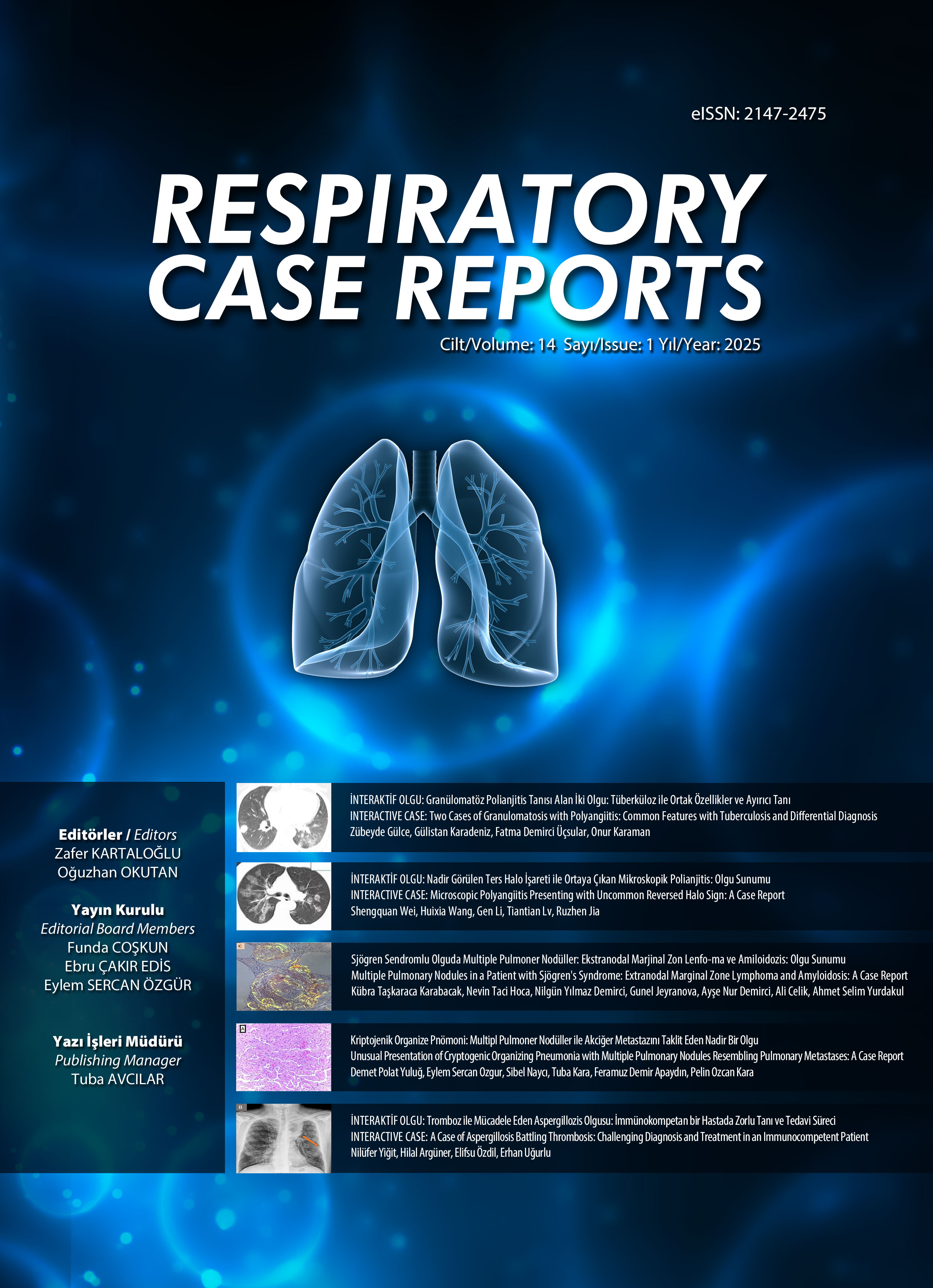e-ISSN 2147-2475

Cilt: 8 Sayı: 1 - Şubat 2019
| OLGU SUNUMU | |
| 1. | Akciğer Kanseri Olarak Yanlış Tanı Alan İmmün Sistemi Sağlıklı EBUS-TBİA ile İnvazif Pulmoner Aspergillozis Tanısının Konan Bir Olgu A Case of Invasive Pulmonary Aspergillosis in an Immunocompetent Patient Diagnosed by EBUS-TBNA, Misdiagnosed as Lung Cancer. Taeyun Kim, Hyunji Choi, Jinyoung Lee, Jehun Kimdoi: 10.5505/respircase.2019.49140 Sayfalar 1 - 5 Aspergillozis örnekleri doğada yaygın olarak bulunmaktadır. Aspergillus, immün sistemi bozulmuş hastalarda hayatı tehdit eden invazif pulmoner aspergillozise (IPA) neden olabilmektedir. IPA semptomları nonspesifik ve radyolojik bulguları çeşitli olduğu için tanısı zor bir hastalıktır. Göğüs üst kısmında iki haftadır devam ağrı nedeniyle, 68 yaşındaki kadın hasta Göğüs Hastalıkları bölümüne yönlendirilmişti. Bilgisayarlı tomografide akciğer kanserinden şüphe edildi. Endobronşial ultrason rehberliğinde transbronşial iğne aspirasyonu (EBUS-TBİA) yapıldı ve IPA tanısı histolojik olarak kondu. Bu, Korede EBUS-TBİA ile IPA tanısı konan ilk olgu sunumudur. Kitlesel akciğer lezyonlarının tanısında EBUS-TBİAnın rolünün artması beklenmektedir. |
| 2. | Mesleksel Eksojen Lipoid Pnömoni: Genellikle Gecikmiş Tanı Occupational Exogenous Lipoid Pneumonia: A Commonly Delayed Diagnosis Feriel Dhouib, Mounira Hajjaji, Kaouthar Jmal Hammami, Mohamed Larbi Masmoudidoi: 10.5505/respircase.2019.19971 Sayfalar 6 - 9 Exogenous lipoid pnömoni seyrek görülen bir hastalıktır ve mesleksel etyoloji de nadirdir. Mesleki maruziyete bağlı olgular, genellikle sifonerler ve ateş yutanlar gibi lipid maddelerin aspirasyonundan kaynaklanırlar. Biz, makinaları onaran ve yağlama için yağ spreyi kullanan bir hastada, eksojen lipoid pnömoni olgusunu sunuyoruz. Hastanın mesleki maruziyetlerinin ihmal edilmesi nedeniyle tanısı iki yıl gecikmişti. Ana tedavi, nedensel ajana maruz kalmanın önlenmesidir. İzlemlerinde klinik ve radyolojik iyileşme görüldü. |
| 3. | Soliter Pulmoner Nodül ile Karışan Pulmoner Arteriovenöz Malformasyon Olgusu A Case of Pulmonary Arteriovenous Malformation Mimicking Solitary Pulmonary Nodule Fatmanur Çelik Başaran, Canan Doğan, Mine Gayaf, Ahmet Emin Erbaycudoi: 10.5505/respircase.2019.54771 Sayfalar 10 - 13 Pulmoner arteriyovenöz malformasyonlar (PAVMs) pulmoner arter ve venler arasındaki anormal bağlantılardır. Sıklıkla izole anomali şeklinde görülürler ancak multiple olarak Herediter Hemorajik Telenjiektaziye eşlik edebilirler. Genelde asemptomatik olmakla birlikte hemoptizi ve hipoksemi kliniği ile de karşımıza çıkabilmektedir. PAVMler çoğu zaman radyolojik olarak soliter pulmoner nodül veya multipl nodüller ile karışabilmektedir. Bizim olgumuzda da radyolojik olarak soliter pulmoner nodül ile karışan bir radyolojik görünüm mevcuttu. |
| 4. | Nadir Görülen Semptomatik İntrapulmoner Bronkojenik Kist A Rarely Seen Symptomatic Intrapulmonary Bronchogenic Cyst Cenk Balta, Şamil Günaydoi: 10.5505/respircase.2019.98700 Sayfalar 14 - 16 Bronkojenik kistler embriyonal dönemde trakeobronşial ağacın anormal gelişimine bağlı olarak oluşan, nadir görülen benign, kistik oluşumlardır. Normal bronşiyal sistem gibi mukus salgısı yapan hücreler, kıkırdak, elastik doku ve düz kaslar içerir. Çoğunlukla asemptomatik olmakla birlikte nadiren öksürük, ateş ve hemoptizi izlenebilir. Radyolojik olarak homojen kitle ve enfektif olduğunda hava - sıvı seviyesi içeren kistik kitleler olarak karşımıza çıkar. Bu yazıda nadir görülen intrapulmoner semptomatik bronkojenik kist olgusu literatür eşliğinde sunulmuştur. |
| 5. | Pulmoner Emboli Tanısı Hala Bir İkilem mi? Hangi Skorlama Sistemi Bizi Tanıya Götürür?: Olgu Sunumu Is the Diagnosis of Pulmonary Embolism Using Scoring Systems Still a Dilemma?: A Case Report Alten Oskay, Cihangir Çelik, Kıvanç Karaman, Hamit Hakan Armağan, Önder Tomrukdoi: 10.5505/respircase.2019.35762 Sayfalar 17 - 20 Pulmoner emboli (PE) tanısını kolaylaştırmak, hastaların acil servisten güvenle taburculuğunu sağlayabilmek, hastaları iyonizan radyasyon ve opak maddelerin komplikasyonlarından koruyabilmek için çeşitli skorlama sistemleri kullanılmaktadır. Altmış altı yaşında aktif erkek hasta acil servise geçirmiş olduğu senkop nedeniyle getirildi. Hasta batıcı tarzdaki göğüs ağrısından, hemoptizi ve hafif bir retrosternal sıkıntı hissinden şikayetçiydi. Vital bulgularında hipoksemisi (SpO2=88%) mevcuttu. D-dimer değeri 165ng/mL (normal sınırlar: 69-243) olarak saptandı. PE olasılığı 2 kategorili Wellste düşük, D-dimer negatifliği ile birlikte değerlendirilen rGeneva skorlama sistemlerinde %2 olarak öngörülmesine ve YEARS skalasında tamamen dışlanmasına rağmen hastaya pulmoner bilgisayarlı tomografi anjiografi çekildi. Her iki ana pulmoner arterde pulmoner emboli saptandı. Sıklıkla kullanılan skorlama sistemlerinin tedavi gerektiren PEyi tanımakta yetersiz kalabildikleri görülmektedir. Klinik algının üstün olduğu bazı noktalar hala vardır. |
| 6. | Plevral Mezotelyomalı Bir Hastada Bilateral Non-arteritik İskemik Optik Nöropati ve Minimal Değişiklik Hastalığı Minimal change disease and bilateral non-arteritic ischemic optic neuropathy in a patient with pleural mesothelioma Senyo Tagbotodoi: 10.5505/respircase.2019.14471 Sayfalar 21 - 25 Malign mezotelyoma tipik olarak yavaş ilerleyen dispne ve göğüs ağrısı ile kendini göstermektedir. Toraks dışı semptomlar ve paraneoplastik tablolar çok nadirdir. Bu maliginite ile glomerüler hastalık birlikteliği literatürde nadiren bildirilmiştir. Bu olgu sunumunda, 26 yıl önce mesleksel asbest maruziyeti olan son bir aydır yavaş ilerleyen görme kaybı, hafif kilo kaybı ve ayaklarda ödem yakınmaları olan 65 yaşında erkek hasta sunulmuştur. Göz hastalıkları uzmanları tarafından non-arteritik iskemik optik nöropati geliştiği belirlendi. İleri nefrolojik incelemelerde renal biyopsi ile doğrulanan minimal değişiklik hastalığına bağlı nefrotik sendrom olduğu gösterildi. Steroid tedavisi ile klinik semptomlar hızla düzeldi. Nefrotik sendrom ve ilerleyici görme kaybı klinik olarak remisyona girdi ve kilo kaybı düzeldi. Başlangıç akciğer grafisi yalnızca kronik değişiklikler gösteriyordu. Sekiz ay sonra nefes darlığı ve göğüs ağrısı semptomları ortaya çıktı ve sağ da yoğun plevral sıvı saptandı. İleri incelemelerde plevral mezotelyoma tespit edildi. |
| 7. | Fluorourasil, Leucoverin ve Oxaliplatin Tedavisine Sekonder Akciğer Toksistesi: Olgu Sunumu Pulmonary Toxicity Secondary to Fluorouracil, Leucoverin and Oxaliplatin Treatment: A Case Report Fatma Tokgöz Akyıl, Mustafa Akyil, Erdem Şen, Meltem Ağca, Tülin Sevimdoi: 10.5505/respircase.2019.43433 Sayfalar 26 - 30 Günümüzde, FOLFOX (5-fluorourasil, leucoverin ve oxaliplatin) ileri evre veya metastatik gastrointestinal sistem tümörlerinde ilk sırada kullanılan kemoterapötik rejimdir. Bu rejimin hematolojik, gastrointestinal ve sensörinöral sistem ile ilgili yan etkileri bilinmesine karşın pulmoner toksisitesi sınırlı sayıda olgu bildirimleri düzeyindedir. Hızla ilerleyerek mortal seyredebileceğinden akciğer toksisitesinin erken farkındalığı ve tedavisi önemlidir. Bu yazıda, metastatik özofagus kanseri nedeniyle kullanılan FOLFOX tedavisine sekonder gelişen interstisyel akciğer hastalığı olgusu nadir olması nedeniyle sunulmuştur. |
| 8. | Tc-99m DTPA Klirens Yönteminin Amiodaron'un İndüklediği Akciğer Hasarının Uzun Dönem Takibinde Tanısal Gücü The Diagnostic Facility of Tc-99m DTPA Clearance Method in the Long Term Follow-up of Improvement of Amiodarone-Induced Lung Damage Zehra Pınar Koç, Pelin Özcan Kara, Mukadder Çalıkoğludoi: 10.5505/respircase.2019.59251 Sayfalar 31 - 34 Amiodaronun tetiklediği akciğer hasarı (ATAH) bu ilacın doz kısıtlayıcı önemli bir yan etkisi olup tanısı klasik morfolojik yöntemlerle zordur. Amiodaron önemli bir antiaritmik ilaç olsa da ciddi yan etkileri olup bunlardan birisi de akciğer hasarıdır. Daha önceki gözlemler, Tc-99m DTPA klirensi hesaplanmasının bu akciğer hasarını göstermede doğru bir yöntem olduğunu göstermiştir. Elli sekiz yaşında erkek hasta, antiaritmik ilaç olarak amiodaron kullanmaktaydı. Hasta dispne yakınması ile geldi ancak konvansiyonel BT sonucu tanısal bir bulgu vermedi. ATAH tanısı ve ilacın kesilmesinden sonra uzun dönem takibinde Tc-99m DTPA görüntüleme yöntemi kullanıldı. Bu olgu sunumu, Tc-99m DTPA klirensinin ATAH tanısı ve uzun dönem tedavi takibinde yeterli bir metod olduğunu göstermektedir. |
| 9. | Hiperkapnik Solunum Yetmezliği ve Yüksek Akım Nazal Oksijen Tedavisi Hypercapnic Respiratory Failure and High Flow Nasal Oxygen Therapy Fatma İrem Yeşiler, Deniz Kosovalı, Ümit Gökhan Şendur, Abdülhamit Sutukoğlu, Mustafa Kemal Bayardoi: 10.5505/respircase.2019.47113 Sayfalar 35 - 39 Akut hipoksemik solunum yetmezlikli hastalarda, konvansiyonel oksijen tedavisi yerine son yıllarda ısıtılmış ve nemlendirilmiş yüksek akımda oksijenin nasal kanülle (HFNC) uygulanması popülarite kazanmıştır. Bu uygulama ile anatomik ölü boşluk, nazofaringeal direnç azalması, pozitif ekspiratuar basınç etki ve alveoler rekrütment sağlanır. Hastaların konforu ve toleransını arttırdığı, solunum işini ve sayısını azalttığı ve değişik etyolojilere bağlı solunum yetersizliklerinde solunum desteğini arttırma gereksinimini azalttığı saptanmıştır. Hiperkapnik solunum yetmezlikli hastalarda da solunum işini, solunum sayısını azalttığını, ventilasyon etkinliğini, tidal volümü ve egzersiz toleransını arttırdığını gösteren çalışmalar mevcuttur. İki olgumuzu da kronik obstrüktif akciğer hastalığına bağlı hiperkapnik solunum yetmezliğinde noninvaziv mekanik ventilasyon tedavisinin etkin olmadığı durumlarda yüksek akımda oksijenin nasal kanülle uygulanmasının etkinliğini göstermek ve kullanımına yönelik farkındalığı arttırmak amacıyla sunuyoruz. |











